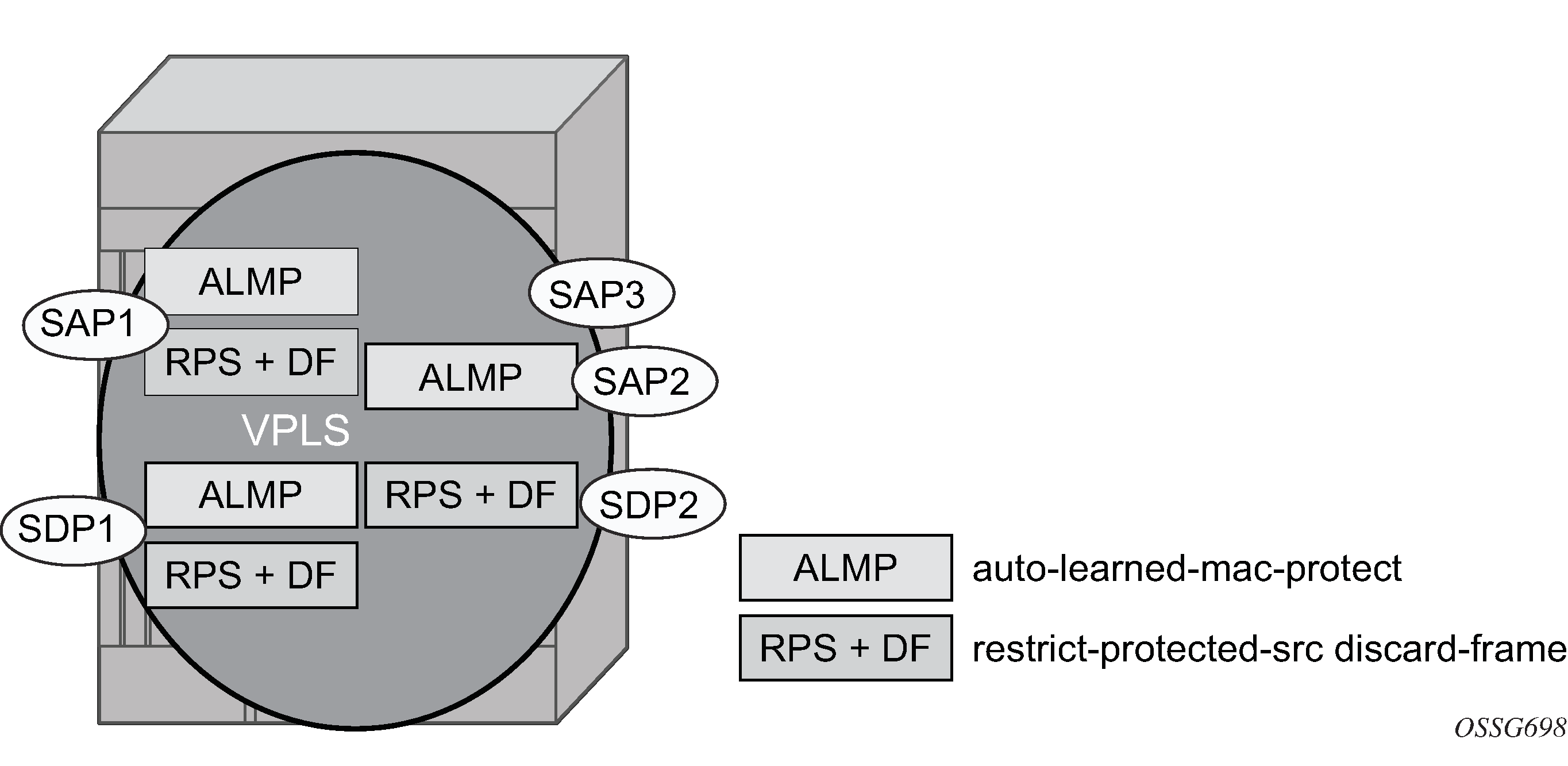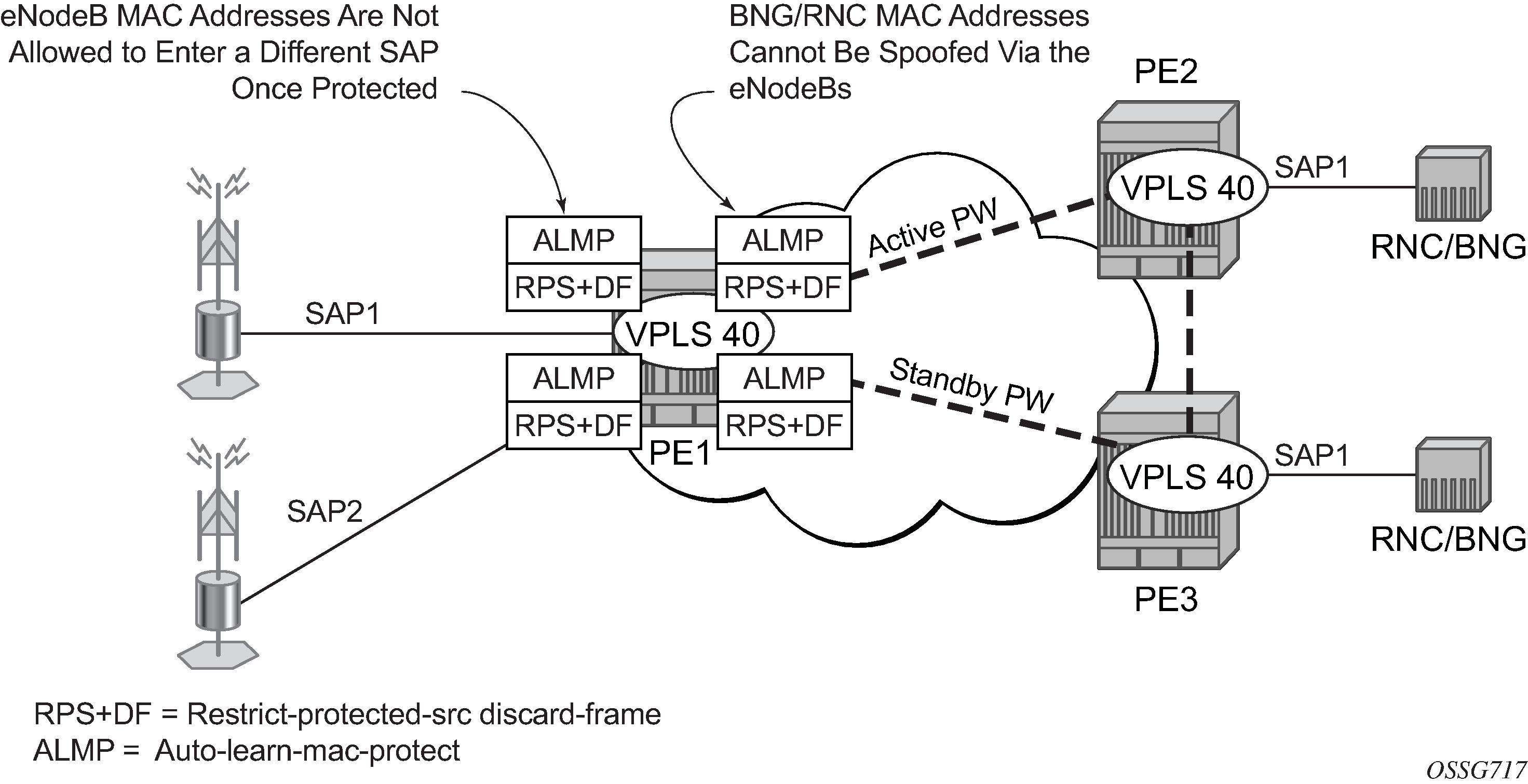Figure 1 shows a specific configuration using auto-learn-mac-protect and restrict-protected-src discard-frame to describe their operation for the 7750 SR, 7450 ESS, or 7950 XRS.

A VPLS service is configured with SAP1 and SDP1 connecting to access devices and SAP2, SAP3, and SDP2 connecting to the core of the network. The auto-learn-mac-protect feature is enabled on SAP1, SAP3, and SDP1, and restrict-protected-src discard-frame is enabled on SAP1, SDP1, and SDP2. The following series of events describes the details of the functionality:
Assume that the FDB is empty at the start of each sequence.
Sequence 1:
A frame with source MAC A enters SAP1, MAC A is learned on SAP1, and MAC-A/SAP1 is protected because of the presence of the auto-learn-mac-protect on SAP1.
All subsequent frames with source MAC A entering SAP1 are forwarded into the VPLS.
Frames with source MAC A enter either SDP1 or SDP2, these frames are discarded, and an alarm indicating MAC A and SDP1/SDP2 is initiated because of the presence of the restrict-protected-src discard-frame on SDP1/SDP2.
The above continues, with MAC-A/SAP1 protected in the FDB until MAC A on SAP1 is removed from the FDB.
Sequence 2:
A frame with source MAC A enters SAP1, MAC A is learned on SAP1, and MAC-A/SAP1 is protected because of the presence of the auto-learn-mac-protect on SAP1.
A frame with source MAC A enters SAP2. As restrict-protected-src is not enabled on SAP2, MAC A is relearned on SAP2 (but not protected), replacing the MAC-A/SAP1 entry in the FDB.
All subsequent frames with source MAC A entering SAP2 are forwarded into the VPLS. This is because restrict-protected-src is not enabled SAP2 and auto-learn-mac-protect is not enabled on SAP2, so the FDB is not changed.
A frame with source MAC A enters SAP1, MAC A is relearned on SAP1, and MAC-A/SAP1 is protected because of the presence of the auto-learn-mac-protect on SAP1.
Sequence 3:
A frame with source MAC A enters SDP2, MAC A is learned on SDP2, but is not protected as auto-learn-mac-protect is not enabled on SDP2.
A frame with source MAC A enters SDP1, and MAC A is relearned on SDP1 because previously it was not protected. Consequently, MAC-A/SDP1 is protected because of the presence of the auto-learn-mac-protect on SDP1.
Sequence 4:
A frame with source MAC A enters SAP1, MAC A is learned on SAP1, and MAC-A/SAP1 is protected because of the presence of the auto-learn-mac-protect on SAP1.
A frame with source MAC A enters SAP3. As restrict-protected-src is not enabled on SAP3, MAC A is relearned on SAP3 and the MAC-A/SAP1 entry is removed from the FDB with MAC-A/SAP3 being added as protected to the FDB (because auto-learn-mac-protect is enabled on SAP3).
All subsequent frames with source MAC A entering SAP3 are forwarded into the VPLS.
A frame with source MAC A enters SAP1, these frames are discarded, and an alarm indicating MAC A and SAP1 is initiated because of the presence of the restrict-protected-src discard-frame on SAP1.
Example Use
Figure 2 shows a possible configuration using auto-learn-mac-protect and restrict-protected-src discard-frame in a mobile backhaul network, with the focus on PE1 for the 7750 SR or 7950 XRS.

To protect the MAC addresses of the BNG/RNCs on PE1, the auto-learn-mac-protect command is enabled on the pseudowires connecting PE1 to PE2 and PE3. Enabling the restrict-protected-src discard-frame command on the SAPs toward the eNodeBs prevents frames with the source MAC addresses of the BNG/RNCs from entering PE1 from the eNodeBs.
The MAC addresses of the eNodeBs are protected in two ways. In addition to the above commands, enabling the auto-learn-mac-protect command on the SAPs toward the eNodeBs prevents the MAC addresses of the eNodeBs being learned on the wrong eNodeB SAP. Enabling the restrict-protected-src discard-frame command on the pseudowires connecting PE1 to PE2 and PE3 protects the eNodeB MAC addresses from being learned on the pseudowires. This may happen if their MAC addresses are incorrectly injected into VPLS 40 on PE2/PE3 from another eNodeB aggregation PE.
The above configuration is equally applicable to other Layer 2 VPLS-based aggregation networks; for example, to business or residential service networks.